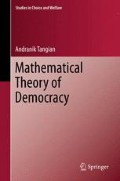Abstract
The model of representatives is applied to find the city street intersections whose traffic situations somehow foreshadow the conditions at other intersections, meaning that some intersections can be considered representatives of others. These representative intersections are forecasters of the jams that could be prevented by switching the ‘green wave’ (coordination of traffic lights to allow continuous traffic flow over several intersections) in the appropriate direction before a slow-down can form. The most representative intersections for forecasting are found using the indices of popularity and universality. Moreover, groups of intersections are arranged into ‘parliaments’, making ‘decisions’ by majority rule. This approach is illustrated by an example of forecasting traffic congestions on the City Ring in Hagen, Germany, based on information from intersections all around the town. The predictive capacity of single forecasters and small groups thereof arranged in parliaments is statistically tested. It is shown that just a few appropriately selected intersections are sufficient to make reliable predictions.
Standing in the middle of the road is very dangerous; you get knocked down by the traffic from both sides.
Margaret Thatcher (1925–2013)
Access this chapter
Tax calculation will be finalised at checkout
Purchases are for personal use only
Preview
Unable to display preview. Download preview PDF.
References
Bell MGH (ed) (1999) Transportation networks: recent methodologicaladvances. Elsevier, Oxford
Camacho E, Bordons C (1995) Model predictivecontrol in the process industry. Springer, Berlin
de Schutter B (2002) Optimizing acyclic traffic signals switchingsequences through an extended linear complementarity problem formulation.Eur J Oper Res 139(2):400–415
de Schutter B, de Moor B (1998) Optimal trafficlight control for a single intersection. Eur J of Control 4(3):260–276
Findler NV (1999) Harmonization for omnidirectional progressionin urban traffic control. Computer-Aided Civil and Infrastructure Engineering14:369–377
Gazis DC (ed) (1974) Traffic science. Wiley, New York
Gazis DC (2002) The origins of traffic theory. Oper Res 50(1):69–77
Hegyi A, de Schutter B, Hellendoorn J (2003) MPC-based optimalcoordination of variable speed limits to suppress shock waves in freewaytraffic. Proceedings of the 2003 American Control Conference, Denver, Colorado,June 2003, 4083–4088
Herman R, Prigogine I (1979) A two fluid approachto town traffic. Science 204:148–151
Kashani HR, Saridis GN (1983) Intelligent control forurban traffic systems. Automatica 19(2):191–197
Kotsialos A, PapageorgiouM, Middelham F (2001) Optimalcoordinated ramp metering with advanced motorway optimal control. In: Proceedingsof the 80th annualmeeting of the Transportation research board,WashingtonDC, Number 01-3125
Leutzbach W (1988) Introduction to the theory of traffic flow.Springer, Berlin
Maciejowski J (2002) Predictive control with constraints.Prentice-Hall, Harlow520 14 Application to Traffic Control
May AD (1990) Traffic flow fundamentals. Prentice-Hall, EnglewoodCliffs NJ.
Mϋhlenbein H, Bartling U, Beyer U (2001) City-traffic: anartificial reality system of traffic in an urban area. ERCIM News 46.http://www.ercim.eu/publication/Ercim News/enw46/muehlen.html. Cited 11May 2013
Papageorgiou M, Blosseville JM, Hadj-Salem H (1990)Modelling and real-time control of traffic flow on the southern part of BoulevardP´eriph´erique in Paris. Parts I and II. Transport Res A-Pol 24A(5):345–370
Park ES, Lim JH, Suh IH, Bien Z (1984) Hierarchical optimalcontrol of urban traffic networks. Int J Control 40(4):813–829
Prigogine I, Herman R (1971) Kinetic theory of vehiculartraffic. Elsevier, New York
Singh MG, Tamura H (1974) Modelling and hierarchicaloptimization for oversaturated urban road traffic networks. Int J Control20(6):913–934
Tangian A (2007) Selecting predictors for traffic control by methodsof the mathematical theory of democracy. Eur J Operational Research,181:986–1003
Author information
Authors and Affiliations
Rights and permissions
Copyright information
© 2014 Springer-Verlag Berlin Heidelberg
About this chapter
Cite this chapter
Tangian, A. (2014). Application to Traffic Control. In: Mathematical Theory of Democracy. Studies in Choice and Welfare. Springer, Berlin, Heidelberg. https://doi.org/10.1007/978-3-642-38724-1_14
Download citation
DOI: https://doi.org/10.1007/978-3-642-38724-1_14
Published:
Publisher Name: Springer, Berlin, Heidelberg
Print ISBN: 978-3-642-38723-4
Online ISBN: 978-3-642-38724-1
eBook Packages: Business and EconomicsEconomics and Finance (R0)

